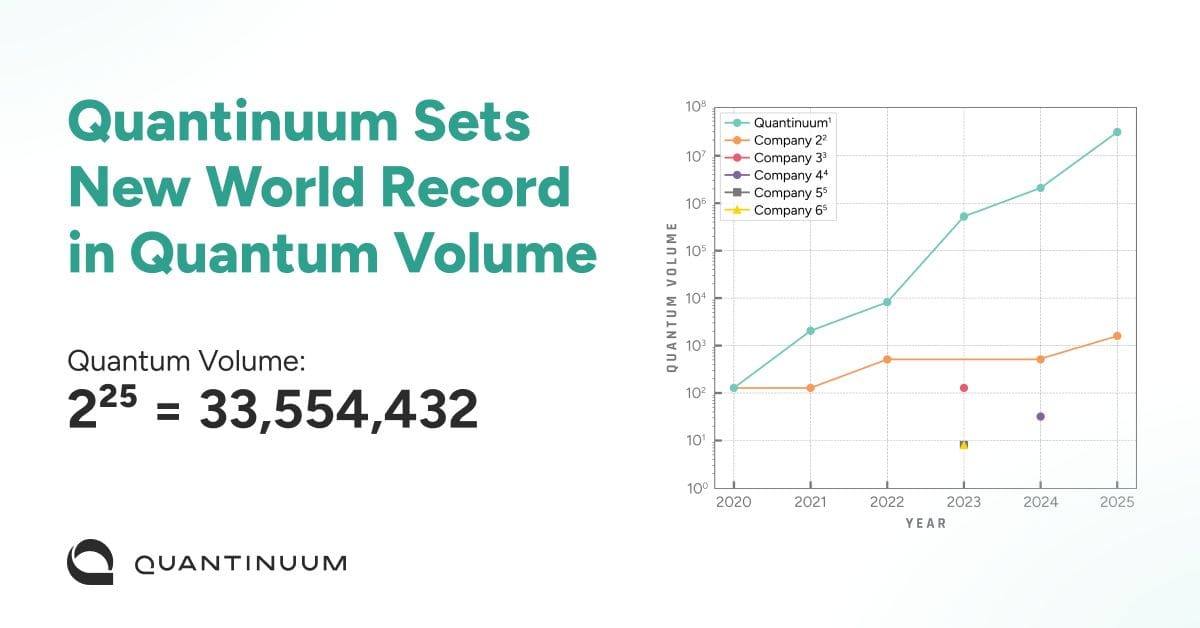Quantinuum announced that its flagship quantum computer achieved a quantum volume of 33.5 million, a four‑fold increase over the 8 million target set in a five‑year challenge met in May. The benchmark is the highest ever recorded, surpassing the next best system by a factor of 16 000. The announcement appeared in a LinkedIn post dated one day ago, underscoring the company’s continued leadership in quantum hardware performance. The quantum‑volume metric, devised by IBM in 2020, requires qubit count, gate fidelity, connectivity and other critical parameters to operate in concert.
The test involves generating at least 100 random circuits, each pairing qubits, applying a randomly chosen two‑qubit gate, and repeating for a number of rounds equal to the qubit count. The output of each circuit is compared against a full state‑vector simulation using a heavy‑output‑probability (HOP) test; a system passes if the average HOP exceeds two‑thirds with a two‑sigma confidence level.
IBM Originated Benchmark Quantinuum Leads Since 2021
Since 2021, Quantinuum has consistently topped IBM’s quantum‑volume benchmark, which is a system‑level assessment demanding reliable performance across all architecture elements. The assessment generates a suite of no fewer than 100 random circuits, each applying a two‑qubit gate chosen from the device’s native gate set and repeating for a number of rounds equal to the qubit count. The output distribution of each run is compared against a perfect state‑vector simulation; the average probability of the most probable outputs must exceed two‑thirds with a confidence interval equivalent to two standard deviations for the system to achieve that QV level. In addition to the QV test, Quantinuum evaluates its hardware using Greenberger–Horne–Zeilinger (GHZ) state fidelity. The protocol employs a logarithmic‑depth GHZ preparation sequence, after which populations and coherences of the resulting state are measured without any state‑preparation or measurement (SPAM) correction. A fidelity above 0.5 confirms genuine n‑body entanglement.
On the 56‑qubit H2‑1 device, the fidelity measurement satisfied this threshold, but the populations of the all‑zeros and all‑ones states were unequal, revealing a 20 % probability of measuring a state other than the expected two, indicating asymmetry in SPAM errors. Parity measurements, which should oscillate between +1 and –1 with a period scaling with the number of qubits, further confirmed the presence of superposition. Quantinuum’s public data set tracks heavy‑output frequency and GHZ fidelity improvements from 2020 through 2025, illustrating a clear trajectory of performance gains. The demonstrated 56‑qubit entanglement capability confirms that a high quantum volume reflects not only qubit count and gate fidelity but also the hardware’s capacity to generate large, coherent entangled states, a prerequisite for algorithms such as quantum simulation and error‑correcting codes.
Quantinuum announced that its new Helios system will be deployed later this year and is expected to raise performance to a level never before achieved, signalling a decisive step beyond the 33.5 million quantum‑volume record. While the announcement did not disclose technical details, the implication is that Helios will push the limits of the quantum‑volume metric further than any existing platform, extending the reach of quantum computing hardware and offering customers access to unprecedented computational power. Helios is anticipated to scale qubit count and improve gate fidelity, thereby extending both quantum‑volume and GHZ‑fidelity performance and pushing the boundaries of practical quantum computing even further.
